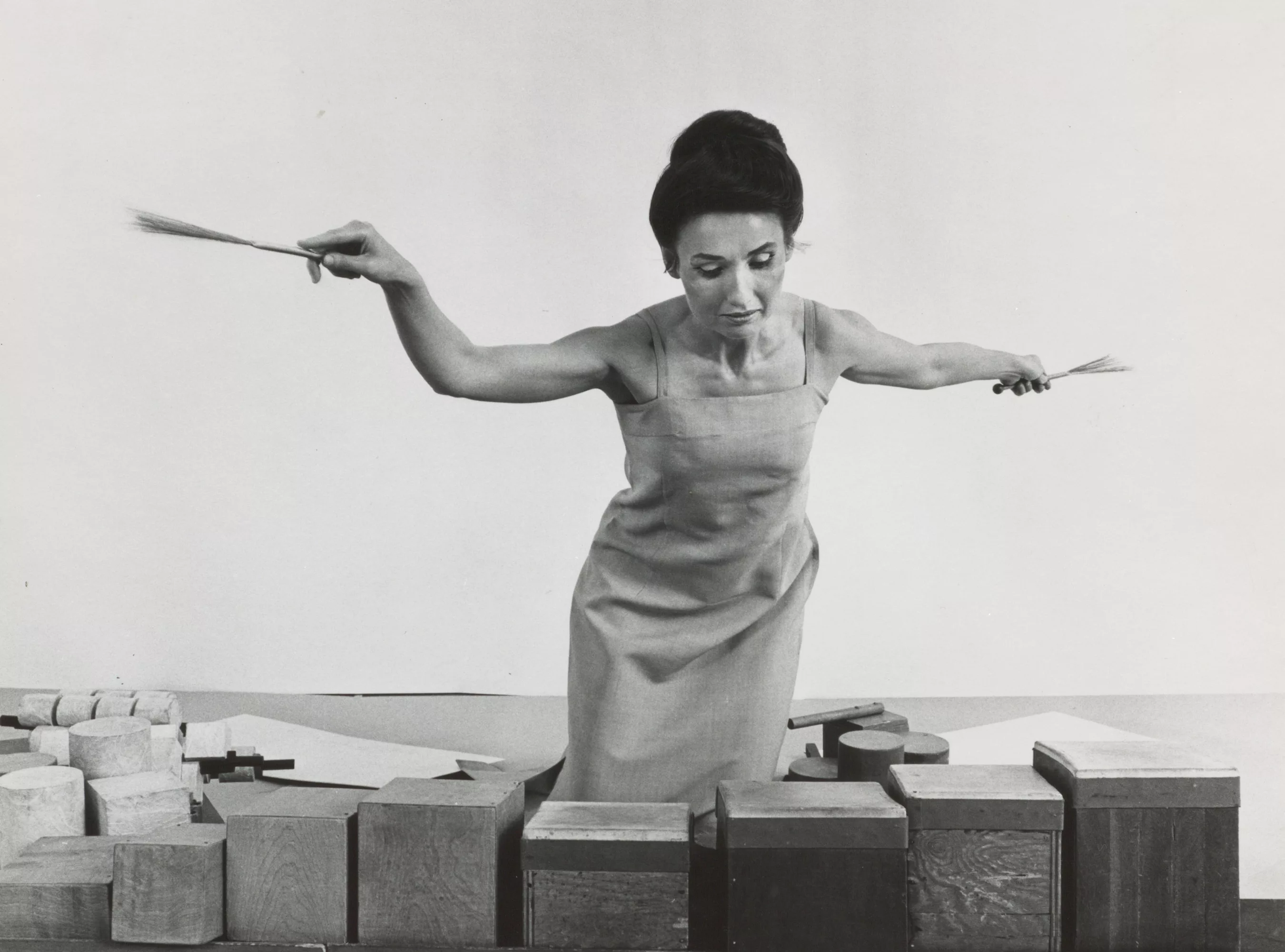
Pure Lucia – Night 1: Quidditas Suchness
May 9 @ 7:30 pm - 10:00 pm
FringeArts
140 N. Columbus Blvd.
Philadelphia,
PA
19106
United States

Bowerbird and FringeArts present Pure Lucia – Night 1: Quidditas Suchness, the first night of a two-part program dedicated to the work of composer Lucia Dlugoszewski. Featuring chamber music, film, and dance, the program highlights key moments in Dlugoszewski’s career, from her early experimental compositions to her long-standing collaboration with choreographer Erick Hawkins. Performers include Network for New Music, percussionist Dustin Donahue, pianist Agnese Toniutti, the David Taylor Brass Quintet, and the Erick Hawkins Dance Company.
Lucia Dlugoszewski’s name is pronounced LOO-sha dwoo-goh-SHEF-skee.
CONCERT PROGRAM
All music by LUCIA DLUGOSZEWSKI (1925 – 2000)
Song for the Poetry of Everyday Sounds to the poem of e e cummings (1952)
Separated Music (1958)
a.) for rates of speed
b.) for delicate accidents
For everyday objects and percussion; Performed by Dustin Donahue, Rachel Beetz, Michelle Purdy, and Andy Thierauf
Visual Variations on Noguchi (1945/1953)
Film by Marie Menken; score by Lucia Dlugoszewski (“The Poetry of Natural Sound”)
Excerpts from Openings of the (Eye) (1952)
Performed by Network for New Music
– Susanna Loewy, flute
– Charlie Abramovic, piano
– Phillip O’Banion, percussion
Angels of the Inmost Heaven (1971)
For brass quintet, performed by:
– Chris Coletti, trumpet
– Peter Evans, trumpet
– Eric Reed, french horn
– Joe Fiedler, tenor trombone
– David Taylor, bass trombone
INTERMISSION
Excerpts from Here and Now With Watchers (1957)
For solo timbre piano and two dancers; choreography by Erick Hawkins. Performed by:
Agnese Toniutti, timbre piano
Erick Hawkins Dance Company
– Jason Hortin
– Hayley Meier
Cantilever (1963)
For solo piano with four dancers; choreography by Erick Hawkins. Performed by:
Agnese Toniutti, piano
Erick Hawkins Dance Company
– Jason Hortin
– Hayley Meier
– JR Gooseberry
– Hailie Landers
This event is part of PURE LUCIA, a retrospective of the life and work of Lucia Dlugoszewski. View the program for the following night: Pure Lucia – Night 2: Duende Otherness
PROGRAM NOTES
This evening includes Dlugoszewski’s Song for the Poetry of Everyday Sounds, a 1952 work that explores the musical possibilities of everyday objects—paper tearing, beans and rice scattering, water pouring. Written in the same year as John Cage’s Water Music, this piece reflects a parallel interest in expanded sound sources. It is followed by Separated Music for Rates of Speed and Separated Music for Delicate Accidents, two works that incorporate Dlugoszewski’s invented percussion instruments, including the ladder harp. These compositions are early studies that led to 8 Clear Places, one of her major works for dance.
Visual Variations on Noguchi, a film by Marie Menken, is accompanied by Dlugoszewski’s 1953 score, The Poetry of Natural Sound, her only tape piece. Created at Louis and Bebe Barron’s pioneering electronic music studio, the work pairs abstracted imagery of Isamu Noguchi’s sculptures with a dense, layered composition that amplifies and manipulates everyday sounds into an intense, textural soundscape.
Openings of the (Eye) marks the beginning of Dlugoszewski’s four-decade collaboration with Erick Hawkins. Composed in 1952 for flute, piano, and percussion, the piece features a demanding and unconventional piano part. It will be performed by Network for New Music, a Philadelphia-based contemporary music ensemble.
Angels of the Inmost Heaven, composed in 1971 for brass quintet, is known for its complex textures, extreme virtuosity, and use of extended techniques. Originally written for an Erick Hawkins dance, the piece was recorded in 1975 by trombonist David Taylor, who worked closely with Dlugoszewski throughout her career. Taylor will also perform in this concert, leading the brass quintet in a rare live presentation of the work.
The second half of the program introduces live dance, with Erick Hawkins’s original choreography performed alongside Dlugoszewski’s music. Here and Now, with Watchers, from 1957, was their second collaboration and the first in which Dlugoszewski performed as a soloist. The music is for timbre piano, a technique she developed that involves direct interaction with the strings and frame to produce a distinct range of sounds. The piece was frequently performed by the Hawkins company through the 1960s. This performance, featuring Italian pianist Agnese Toniutti and the Erick Hawkins Dance Company, has been reconstructed using archival recordings, choreographic notebooks, and musical sketches.
The program closes with Cantilever, premiered in Paris in 1963 and dedicated to Austro-American architect Frederick Kiesler. Initially created for solo piano and four dancers, the work was later adapted for different instrumental settings and larger dance ensembles. This performance presents the original version with choreography by Hawkins and music performed by Toniutti.
Quidditas, as drawn from James Joyce, refers to the essential whatness of a thing—its singular identity revealed in a moment of heightened perception. Suchness speaks to the unmediated experience of reality, where things simply are, free from interpretation or expectation. While quidditas captures the essence of a sound, suchness embraces its presence in time, unfolding without direction or resolution.
The program title Quidditas Suchness reflects Lucia Dlugoszewski’s deep interest in the essence and immediacy of sound. Quidditas speaks to the epiphanic recognition of a sound’s unique identity, while Suchness evokes the unfolding of sound as a presence in time, free from expectation or resolution. Together, these ideas encapsulate Dlugoszewski’s compositional world, where music is not structured toward a goal but experienced as a radical encounter with the present.

